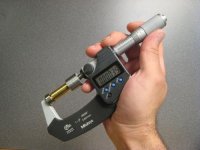Larry,
Given that this fellow, has little to no understanding of Headspace
and its relationship to his ammo, or how to make what he has
work safely . I think what I have said is on target. He , having the gun in hand, has no further control of what his chamber is or how tight it
is. Some of the factory offerings in PPC have very large chamber and can
still be made to shoot, when one understands what he has and where he needs to go. Simply going to your local hardware//sporting goods and
picking up a set of dies marked PPC doesn't cut it. Nor does screwing dies
down on shell holder, without knowing what he is doing.
I offered this explanation in the most basic way, because he did not
seem to follow what Jackie and Greg Walley, Gary Walters
and others said. This is not Rocket science, but some understanding
is needed.
Your guage is nice and well thought out I'm sure, but I have enough
fragile things on my loading table. I can even operate it with out knowing what I'm doing, The only thing that can happen to a solid bump gauge
is I might lose it
Who's the fellow? Who's not safe?? That's quite a stern accusation IMO.
I will say that all the above makes perfect sense and I understand what headspace is, very much so.
I understand that when the case is formed it will be pretty much close to the size of the chamber after the springback.
My rifle is not a factory chamber, generally all I do is necksize and if there is a problem closing the bolt, I will bump the shoulder slightly.
I was simply throwing out a scenario, that if a shooter was to try to measure the headspace in their given rifle, how does a digital gauge or one offered by Hornady, replicate the chamber of your rifle?
Sure I can measure the distance from the base to the datum of the case, is this the
exact same datum that is in my chamber?
The piece Gary showed of the barrel stub which would I assume be cut from the same reamer would be a good tool.
Maybe your actions dont have a strong ejector spring like mine, I have seen gauges that go into the chamber that when you close the bolt, the plunger compresses in the neck and you measure that way. But what if the ejector spring is stronger than the plunger spring and the base of the case is held off the bolt face? That's my question.
No, it's not rocket science, but tell me how you measure the distance from the closed boltface to the datum on the chamber where the shoulder is measured, when the bolt is closed.
Are we taking a fired case and guessing springback?
When I close my bolt, is the base of the case against the boltface, or just a few thou off?
Yes i'm striving for accuracy, and I like to know what makes what work.
What I have done is take a cartridge that is hard to close the bolt, measure the headspace, and use that as a max size. Knock that case back .001 and the bolt closes much easier.
I have no problem measuring
my chamber headspace, took a few cases to determine max length but for the
OTHER shooters that would like to drop in a gauge and read the max distance, how or what would be the easiest way.
1.629" is where I feel alot of resistance, I size to 1.627" and all is good.
The part about the bullet jump is part of "what if the case is pushed forward in the chamber by the spring...would it make much or any difference when you cook it off?
Wasn't trying to demolish the OP's thread, just had a few ???'s.


